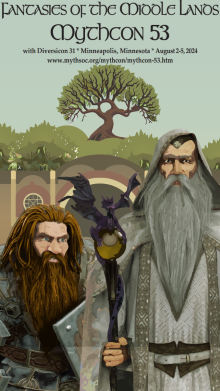Loading...
Location
Minneapolis, Minnesota
Document Type
Presentation
Event Website
https://www.mythsoc.org/mythcon/mythcon-53.htm
Start Date
4-8-2024 9:00 AM
End Date
4-8-2024 9:50 AM
Description
In 2010, only a year before the adaptation of his fantasy novels would air, George R.R. Martin admitted that unlike J.R.R. Tolkien, whom he called a “linguist of rare talent” whose “astonishing feat of linguistic worldbuilding […] is never likely to be duplicated”, Martin himself only invents the words that he needs and does not “have a whole imaginary language” or languages “the way Tolkien did” (Martin 2010). In particular, when it comes to one of his ‘languages’, Dothraki, Martin said that he “did pepper the text with a few […] words” but generally relied on phrases like “[t]hey were speaking Dothraki” to “convey a flavor” (Martin). As he points out, however, this method would not work for audio(visual) adaptations like HBO’s Game of Thrones (2011-2019), in which “you actally [sic] have to HEAR what the characters are saying” (Martin). Those who wish to adapt J.R.R. Tolkien’s The Hobbit, The Lord of the Rings, and other writings are faced with the same problem even though, as Martin alluded to, Tolkien’s principal languages—the Elven tongues Sindarin and Quenya—are highly detailed and developed. Whatever form adaptations of Martin’s and Tolkien’s novels take—auditory, visual, audiovisual, interactive, and others—they have to tackle a number of questions: How should they include the languages in their adaptation and to what extent? What form should these inclusions take? Do they stick with what Martin or Tolkien have already invented, or do they create their own additions and if so, how much and on what basis? In my proposed talk for the 53rd Mythcon, I will present an overview of the use of invented languages in Martin’s and Tolkien’s writings, and how adaptations deal with them.
Creative Commons License

This work is licensed under a Creative Commons Attribution-NonCommercial-No Derivative Works 4.0 International License.
Included in
From Page to Screen: Invented Language in George R.R. Martin’s and J.R.R. Tolkien’s Writings, and How They Are Used in Adaptations
Minneapolis, Minnesota
In 2010, only a year before the adaptation of his fantasy novels would air, George R.R. Martin admitted that unlike J.R.R. Tolkien, whom he called a “linguist of rare talent” whose “astonishing feat of linguistic worldbuilding […] is never likely to be duplicated”, Martin himself only invents the words that he needs and does not “have a whole imaginary language” or languages “the way Tolkien did” (Martin 2010). In particular, when it comes to one of his ‘languages’, Dothraki, Martin said that he “did pepper the text with a few […] words” but generally relied on phrases like “[t]hey were speaking Dothraki” to “convey a flavor” (Martin). As he points out, however, this method would not work for audio(visual) adaptations like HBO’s Game of Thrones (2011-2019), in which “you actally [sic] have to HEAR what the characters are saying” (Martin). Those who wish to adapt J.R.R. Tolkien’s The Hobbit, The Lord of the Rings, and other writings are faced with the same problem even though, as Martin alluded to, Tolkien’s principal languages—the Elven tongues Sindarin and Quenya—are highly detailed and developed. Whatever form adaptations of Martin’s and Tolkien’s novels take—auditory, visual, audiovisual, interactive, and others—they have to tackle a number of questions: How should they include the languages in their adaptation and to what extent? What form should these inclusions take? Do they stick with what Martin or Tolkien have already invented, or do they create their own additions and if so, how much and on what basis? In my proposed talk for the 53rd Mythcon, I will present an overview of the use of invented languages in Martin’s and Tolkien’s writings, and how adaptations deal with them.
https://dc.swosu.edu/mythcon/mc53/schedule/47


